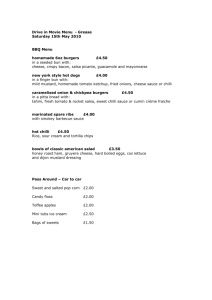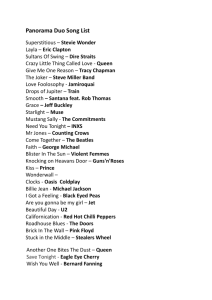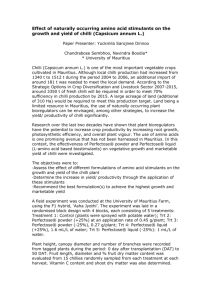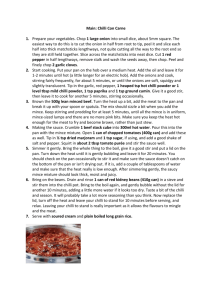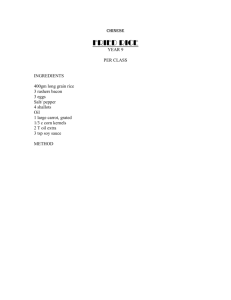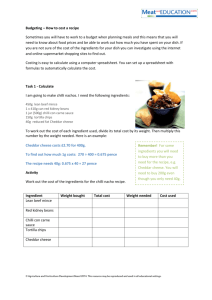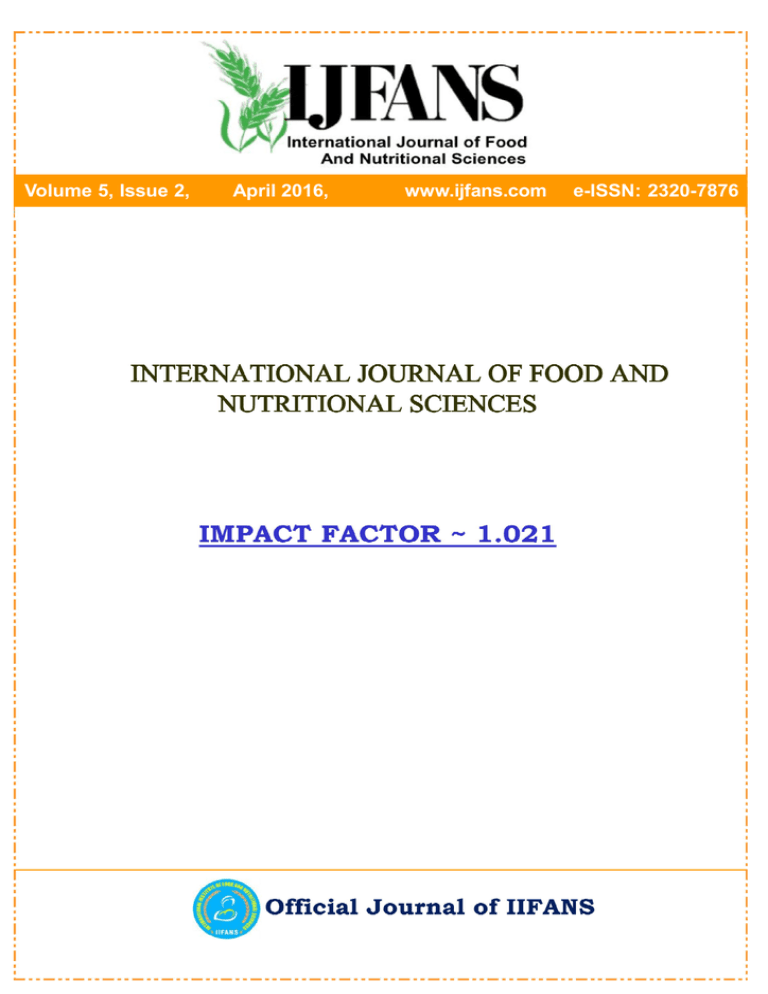
Volume 5, Issue 2,
April 2016,
www.ijfans.com
e-ISSN: 2320-7876
STUDY ON FUNCTIONAL PROPERTIES OF CAPSICUM ANNUUM (GREEN CHILLI)
AND CAPSICUM CHINENSE (YELLOW LANTERN CHILLI)
Jyoti Sharma et al.
e-ISSN 2320 -7876 www.ijfans.com
Vol. 5, No. 2, April 2016
All Rights Reserved
Research Paper
Open Access
STUDY ON FUNCTIONAL PROPERTIES OF CAPSICUM ANNUUM (GREEN
CHILLI) AND CAPSICUM CHINENSE (YELLOW LANTERN CHILLI)
Jyoti Sharma1, Parul Sharma2, Bhawana Sharma3* and Pragati Chaudhary1
*Corresponding Author: Bhawana Sharma, sharma10bhawana@gmail.com
Received on: 21st February, 2016
Accepted on: 31st March, 2016
Objective of this research was to study the functional properties of two capsicum species capsicum annuum
and capsicum chinense. Water absorption capacity of yellow lantern chilli and green chilli was found to be
3.8 and 5.53% respectively. Bulk density of yellow lantern chilli and green chilli was found 0.75 and 0.50 g/ml
respectively. Foaming capacity of yellow lantern chilli and green chilli was found to be 10.13 and 33.36%.
Results of the study indicated that functional properties of yellow lantern chilli and green chilli may cause
improvement in some food products when it is added to them.
Keywords: Functional properties, Bulk density, Water absorption, Foaming capacity
food systems during processing, manufacturing, storage
and preparation (Henshaw et al., 1996; and Jideani, 2011).
These functional properties are greatly dependent on the
specific surface area, which is associated to structural
parameters like total pore volume, porosity, mean pore radius,
particle mean size, particle size distribution and presence of
fine particles (Walton and Mumford, 1999; and Nguyen
et al., 2015). The functional properties of powders are usually
related to the interaction between water/oil and powder.
Functional properties of food also associated with the
protein structure, protein surface, rheological characteristics
and compatibility with other food components (Moure
et al., 2006). Thus functional properties are so important in
determining the nutritional, sensory, physico-chemical and
organoleptic properties of the final food product as well as
enabling processing such as improved machinability of
cookie dough or slicing of processed meats (Jideani, 2011).
Consumer demands have risen remarkably for high quality,
INTRODUCTION
Capsicum, the pungent spice became popular indispensable
spice all over the world.The fresh and dried capsicum fruit
with varying degrees of flavor, pungency, and aroma are
used in diverse cuisines of the world. Utilization of dried
fruit as a carrier of functional ingredients is a relatively novel
concept, although the functional properties of such foods
originated from drying method, where the loss of moisture
results in natural concentration of healthy fruit
(Jesionkowska et al., 2009). Dried foods are concentrated
and have better shelf life than fresh foods due to reduced
moisture contents (Araujo et al., 2004; and Veag-Galvez
et al., 2007). Use of dried products can prevent high losses
of perishables like vegetables during storage. It also makes
seasonal vegetables available throughout the year.
Functional properties are intrinsic physico-chemical
characteristics which affect the act of a food ingredient in
1
M.Sc. student, Department of Home Science, Banasthali University, Tonk 304022 (Rajasthan), India.
2
Assistant Professor, Department of Home Science, Banasthali University, Tonk 304022 (Rajasthan), India.
3
M.Sc. Student, Department of Foods and Nutrition, College of Home Science, Maharana Pratap University of Agriculture and Technology,
Udaipur 313001 (Rajasthan), India.
This article can be downloaded from http:/www.ijfans.com/currentissue.php
37
STUDY ON FUNCTIONAL PROPERTIES OF CAPSICUM ANNUUM (GREEN CHILLI)
AND CAPSICUM CHINENSE (YELLOW LANTERN CHILLI)
Jyoti Sharma et al.
minimally processed products in recent years. Preferences
have shifted towards the healthy and good flavored readyto-eat foods with improved shelf life (Nguyen et al., 2015).
Functional properties are significantly important for
developing a desirable food product for the consumers.
Much of the studies have been conducted on antioxidant
activity and phenolic content of capsicum but very less
stress has been given on the functional properties of
capsicum. Thus the present research was carried out for the
estimation of functional properties (Bulk density, water
absorption and foaming capacity) in two species of capsicum
i.e., Capsicum annuum (green chilli) and Capsicum chinense
(yellow lantern chilli).
Fifty gram capsicum powder was placed in a 100 ml
measuring cylinder. The cylinder was tapped continuously
until a constant volume was obtained. The bulk density
was calculated as weight of the capsicum powder (g) divided
by its volume (ml).
Bulk density
weight of ground capsicum
Volume
Determination of Foaming Capacity
Foaming capacity and stability of capsicum powder samples
were determined by using a method followed by an earlier
study (Aremu et al., 2007). One gram capsicum powder was
dispersed in 50 ml distilled water. The resulting solution
was vigorously whipped for 30 minutes in a Kenwood
blender and poured into a 100 ml graduated cylinder. The
volume before and after whipping was recorded and foaming
capacity was calculated as percentage volume increase.
MATERIALS AND METHODS
The fresh fruits of green and yellow chilli were collected
from Delhi, India during the month of June-October and
identified at Indian Agriculture Research Institute, Delhi.
The variety of green chilli and yellow chilli used for the
study was Capsicum annuum and Capsicum Chinese
respectively. Both species were washed thoroughly with
distilled water. Drying method used for green chilli and
yellow lantern chilli were oven air drying and sun drying
respectively. Dried samples were made in to the fine powder
to use for the further analysis.
The foaming stability was calculated from the equation:
Volume increase %
Volume after whipping Volume before whipping
100
Volume before
Foaming stability was determined as the volume of foam
that be remained after 8 hours expressed as a percentage of
the initial volume.
Determination of Water Absorption
Capacity
RESULTS AND DISCUSSION
Water Absorption Capacity
Water absorption capacity of capsicum powders was
determined using a method followed by an earlier study
(Aremu et al., 2007). One gram capsicum powder was mixed
with 10 ml of distilled water (density of 1 g/cm3) in a centrifuge
tube and allowed to stand at room temperature (30 ºC) for
one hour. It was then centrifuged at 200 rpm for 30 minutes
and the supernatant was noted in a 10 ml graduated cylinder.
Water absorption capacity was calculated as volume of
water (ml) absorbed per gram of the capsicum powder.
Water absorption capacity describes flour – water
association ability under limited water supply. It gives an
indication of volume of water available for gelatinization.
Water binding capacity is a valuable indication of whether
flour or isolates can be unified into aqueous food
formulations.
Table 1 show that water absorption capacity was found
to be 3.8±0.1% in yellow lantern chilli and 5.53±0.11% in
green chilli. The water absorption capacity of jack fruit
powder is 2.3 ml/g (Odoemelam, 2005) while that of water
yam variety is found to have 3.65 ml/g (Udensi et al., 2008).
The tigernut flour is also found to have 1.37 ml/g water
absorption capacity (Oladele and Aina, 2007). The water
absorption capacity of the both capsicum species was found
to be high than jack fruit flour, water yam variety and tigernut
flour. So, all the two varieties of capsicum have medium
water absorption capacity. Hence the powder of both
varieties of capsicum can be incorporated in aqueous food
formulations.
Water absorption capacity was calculated from the
equation:
Water absorption capacity = 10-V
Where V = Volume of water left unabsorbed after
centrifugation.
Determination of Bulk Density
Bulk density of capsicum powders was determined by using
a method followed by an earlier study (Oladele and Aina,
2007).
This article can be downloaded from http:/www.ijfans.com/currentissue.php
38
STUDY ON FUNCTIONAL PROPERTIES OF CAPSICUM ANNUUM (GREEN CHILLI)
AND CAPSICUM CHINENSE (YELLOW LANTERN CHILLI)
Jyoti Sharma et al.
REFERENCES
Table 1: Functional Capacity of Yellow Lantern Chilli and
Green Chilli
Functional
Properties (%)
Yellow Lantern
Chilli
Green
Chilli
Bulk Density
0.75±0.005
0 .55±0.005
Foaming Capacity
10.13±0.15
3 3.36±0.11
Water Absorption
3.8±01
5.53±0.11
Bulk Density
Bulk density is a measure of heaviness of a flour sample. It
gives an indication of the relative volume of packaging
material required. Higher bulk density is desirable for the
greater ease of dispersion and reduction in thickness of
paste. Table 1 depicts that bulk density was found to be
0.55±0.005 g/ml in green chilli and 0.75±0.005 g/ml in yellow
lantern chilli. Similar values for some varieties of legume
seed flour were reported in a study (Aremu et al., 2007).
Yellow lantern chilli has higher bulk density than green
chilli.
•
Akintayo E T, Adebayo E A and Arogundade L A (2002),
“Chemical Composition, Physico-Chemical and
Functional Properties of Akaa Pulp and Seed Flours”,
Food Chem., Vol. 77, pp. 333-336.
•
Araujo E A F, Ribeiro S C A, Azoubel P M and Murr F E
X (2004), “Drying Kinetics of Nectarine (Prunuspersica)
with and without Shrinkage”, in Silva M A and Rocha S
C S (Eds), Drying, Proceedings of the 14th International
Drying Symposium, pp. 2189-2194, Sao Paulo, Brazil.
•
Aremu M O, Olaofe O and Akintayo E T (2007),
“Functional Properties of Some Nigerian Varities of
Legume Seed Flour Concentration Effect on Foaming
and Gelation Properties”, Journal of Food Technology,
Vol. 5, No. 2, pp. 109-115.
•
Fagbemi T N and Oshodi A A (1991), “Chemical
Composition and Functional Properties of Full-Fat
Fluted Pumpkin Seed Flour (Telfairiaoccidentalis)”,
Nig. Food J., Vol. 9, pp. 26-32.
•
Henshaw F O, Mc-Watters K H, Oguntude A O and
Phillips R D (1996), “Pasting Properties of Cowpea Flour:
Effects of Soaking and Decoration Methods”, Journal
of Agriculture and Food Chemistry, Vol. 44, No. 7,
pp. 1864-1870.
•
Jesionkowska K, Sijtsema S J, Konopacka D and
Symoneaux R (2009), “Dried Fruit and its Functional
Properties from a Consumer’s Point of View”, J. Hortic.
Sci. Biotech., Vol. 1, pp. 85-88.
•
Jideani V A (2011), “Functional Properties of Soybean
Ingredients in Food Systems”, Functional-Properties
of Soybean-Food Ingredients-in-Food-Systems,
available from http://www.intechopen.com/book s/
soybean-biochemistry-chemistry-and physiology/
•
Kinsella J E (1979), “Functional Properties of Soy
Proteins”, J. Am. Oil Chemist Soc., Vol. 56, pp. 242-258.
•
Moure A, Sineiro J, Dominguez H and Parajo J C
(2006), “Functionality of Oil Seed Protein Products:
A Review”, Food Research International, Vol. 39,
No. 9, pp. 945-963.
•
Nguyen D Q, Mounir S and Allaf K (2015), “Functional
Properties of Water Holding Capacity, Oil Holding
Capacity, Wet Ability, and Sedimentation of Swell-Dries
Soybean Powder”, Sch. J. Eng. Tech., Vol. 3, No. 4,
pp. 402-412.
Foaming Property
Foaming property is important in cake preparation,
whipping and topping (Kinsella, 1979). Foaming capacity
was found to be10.13±0.15% in yellow lantern chilli
whereas 33.36±0.11% in green chilli. Results are comparable
favorably with benniseed (18.0%), pearl millet (11.3%),
guinea (9.0%) (Oshodi et al., 1999), bilphiasapida pulp
(26.62%), seed flour (8.2%) (Akintayo et al., 2002) and
fluted pumpkin seed flour (10.8%) ( Fagbemi and Oshodi,
1991). Foaming property has been shown to be related to
the amount of native protein. Native protein gives high
foam stability than the denatured protein. The low foaming
capacity of yellow lantern chilli may be due to low soluble
protein content. Hence green chilli can be used to form
foam in food in better manner compared to capsicum
(Kinsella, 1979).
CONCLUSION
Green chilli is more suitable than yellow lantern chilli to be
used in aqueous food and bakery products. Bulk density of
yellow lantern chilli is slightly higher than green chilli which
indicates that cost of the packaging may be economical for
yellow lantern chilli powder when compared to green chilli
powder but the flow of the green chilli powder may be better
than that of yellow lantern chilli.
This article can be downloaded from http:/www.ijfans.com/currentissue.php
39
STUDY ON FUNCTIONAL PROPERTIES OF CAPSICUM ANNUUM (GREEN CHILLI)
AND CAPSICUM CHINENSE (YELLOW LANTERN CHILLI)
Jyoti Sharma et al.
•
Odoemelam S A (2005), “Functional Properties of Raw
and Heat Processed Jackfruit (Artocarpusheterophyllus)
Flour”, Pakistan Journal of Nutrition., Vol. 4, No. 6,
pp. 366-370.
•
Oladele A K and Aina J O (2007), “Chemical Composition
and Functional Properties of Flour Produced from Two
Varieties of Tigernut (Cyperusesculentus)”, African
Journal of Biotechnology, Vol. 6, No. 21, pp. 2473-2476.
•
Oshodi AA,Ogungbenle H N and Oladimeji M O (1999),
“Chemical Compraritis, Nutritionally Valuable Minerals
and Functional Properties of Benniseed, Pearl Millet
and Quinoa Flours”, Int. J.Food Sci. Nut., Vol. 50,
pp. 325-331.
•
Udensi E A, Oselebe H O and Iweala O O (2008), “The
Investigation of Chemical Composition and Functional
Properties of Water Yam (Dioscoreaalata): Effect of
Varietal Differences”, Pakistan Journal of Nutrition,
Vol. 7, No. 2, pp. 342-344.
•
Veag-Galvez A, Uribe E, Lemus-Mondaca R and
Mirandu M (2007), “Hot Air-Drying Characteristics of
Aloe Vera (Aloe barbadensis Miller)and Influence of
Temperature on Kinetic Parameters”, LWT-Food Sci
Tech., Vol. 40, pp. 1698-1707.
•
Walton D E and Mumford G J (1999), “The
Morpholology of Spray-Dried Particles: The Effect of
Process Variables Upon the Morphology of Spray-Dried
Particles”, Chemical Engineering Research and
Design, Vol. 77, No. 5, pp. 442-460.
This article can be downloaded from http:/www.ijfans.com/currentissue.php
40

